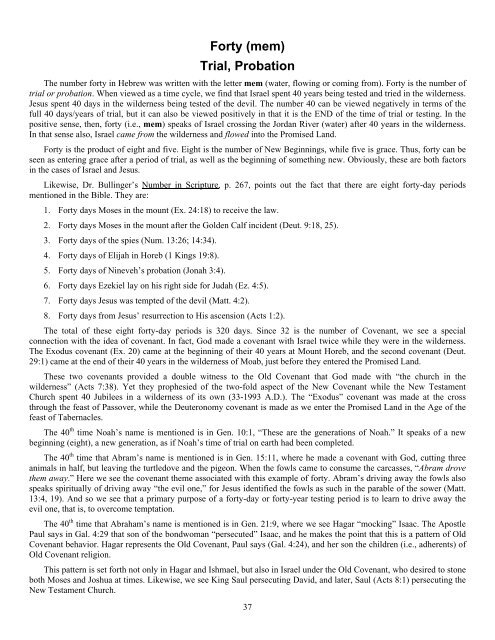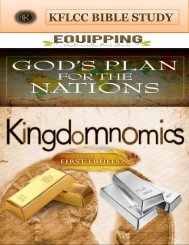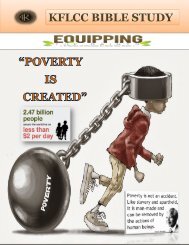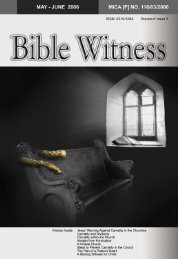You also want an ePaper? Increase the reach of your titles
YUMPU automatically turns print PDFs into web optimized ePapers that Google loves.
Forty (mem)<br />
Trial, Probation<br />
The number forty in Hebrew was written with the letter mem (water, flowing or coming from). Forty is the number of<br />
trial or probation. When viewed as a time cycle, we find that Israel spent 40 years being tested and tried in the wilderness.<br />
Jesus spent 40 days in the wilderness being tested of the devil. The number 40 can be viewed negatively in terms of the<br />
full 40 days/years of trial, but it can also be viewed positively in that it is the END of the time of trial or testing. In the<br />
positive sense, then, forty (i.e., mem) speaks of Israel crossing the Jordan River (water) after 40 years in the wilderness.<br />
In that sense also, Israel came from the wilderness and flowed into the Promised Land.<br />
Forty is the product of eight and five. Eight is the number of New Beginnings, while five is grace. Thus, forty can be<br />
seen as entering grace after a period of trial, as well as the beginning of something new. Obviously, these are both factors<br />
in the cases of Israel and Jesus.<br />
Likewise, Dr. Bullinger’s Number in Scripture, p. 267, points out the fact that there are eight forty-day periods<br />
mentioned in the Bible. They are:<br />
1. Forty days Moses in the mount (Ex. 24:18) to receive the law.<br />
2. Forty days Moses in the mount after the Golden Calf incident (Deut. 9:18, 25).<br />
3. Forty days of the spies (Num. 13:26; 14:34).<br />
4. Forty days of Elijah in Horeb (1 Kings 19:8).<br />
5. Forty days of Nineveh’s probation (Jonah 3:4).<br />
6. Forty days Ezekiel lay on his right side for Judah (Ez. 4:5).<br />
7. Forty days Jesus was tempted of the devil (Matt. 4:2).<br />
8. Forty days from Jesus’ resurrection to His ascension (Acts 1:2).<br />
The total of these eight forty-day periods is 320 days. Since 32 is the number of Covenant, we see a special<br />
connection with the idea of covenant. In fact, God made a covenant with Israel twice while they were in the wilderness.<br />
The Exodus covenant (Ex. 20) came at the beginning of their 40 years at Mount Horeb, and the second covenant (Deut.<br />
29:1) came at the end of their 40 years in the wilderness of Moab, just before they entered the Promised Land.<br />
These two covenants provided a double witness to the Old Covenant that God made with “the church in the<br />
wilderness” (Acts 7:38). Yet they prophesied of the two-fold aspect of the New Covenant while the New Testament<br />
Church spent 40 Jubilees in a wilderness of its own (33-1993 A.D.). The “Exodus” covenant was made at the cross<br />
through the feast of Passover, while the Deuteronomy covenant is made as we enter the Promised Land in the Age of the<br />
feast of Tabernacles.<br />
The 40 th time Noah’s name is mentioned is in Gen. 10:1, “These are the generations of Noah.” It speaks of a new<br />
beginning (eight), a new generation, as if Noah’s time of trial on earth had been completed.<br />
The 40 th time that Abram’s name is mentioned is in Gen. 15:11, where he made a covenant with God, cutting three<br />
animals in half, but leaving the turtledove and the pigeon. When the fowls came to consume the carcasses, “Abram drove<br />
them away.” Here we see the covenant theme associated with this example of forty. Abram’s driving away the fowls also<br />
speaks spiritually of driving away “the evil one,” for Jesus identified the fowls as such in the parable of the sower (Matt.<br />
13:4, 19). And so we see that a primary purpose of a forty-day or forty-year testing period is to learn to drive away the<br />
evil one, that is, to overcome temptation.<br />
The 40 th time that Abraham’s name is mentioned is in Gen. 21:9, where we see Hagar “mocking” Isaac. The Apostle<br />
Paul says in Gal. 4:29 that son of the bondwoman “persecuted” Isaac, and he makes the point that this is a pattern of Old<br />
Covenant behavior. Hagar represents the Old Covenant, Paul says (Gal. 4:24), and her son the children (i.e., adherents) of<br />
Old Covenant religion.<br />
This pattern is set forth not only in Hagar and Ishmael, but also in Israel under the Old Covenant, who desired to stone<br />
both Moses and Joshua at times. Likewise, we see King Saul persecuting David, and later, Saul (Acts 8:1) persecuting the<br />
New Testament Church.<br />
37

















